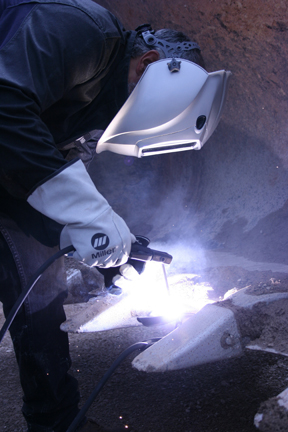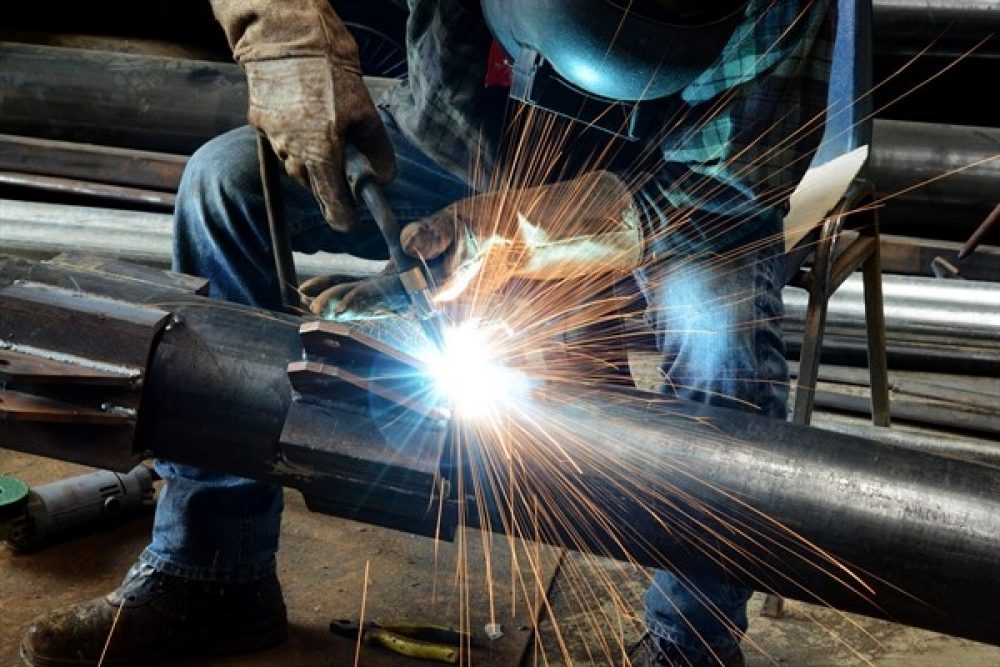Common Welding Repair Work Issues and Exactly How to Address Them Properly
Welding fixings commonly encounter a range of concerns that can threaten the stability of the end product. Typical problems consist of inadequate penetration, porosity, and misalignment, among others. Each problem provides one-of-a-kind obstacles that need certain approaches for resolution. Comprehending these issues is vital for welders aiming to improve their end results and abilities. This conversation will certainly check out these common welding repair work issues and effective approaches to address them.
Insufficient Penetration
Insufficient penetration takes place when the weld steel falls short to fully fuse with the base product, resulting in weak joints and possible structural failings. This problem usually comes from insufficient heat input, wrong electrode angle, or improper welding rate. Welders may run into poor infiltration as a result of a miscalculation of the essential parameters for a particular product density or kind. In addition, contamination on the base product's surface can impede efficient bonding, exacerbating the problem. To resolve poor penetration, welders ought to guarantee suitable setups on their devices and keep a clean job surface area. Routine assessment of welds is suggested to identify any shortages early, enabling prompt corrections and the avoidance of endangered structural integrity in welded settings up.
Porosity
Porosity is an usual flaw in welded joints that manifests as tiny gas bubbles caught within the weld steel. This flaw can endanger the integrity of the weld, causing reduced toughness and potential failing under stress and anxiety. Welding. Porosity normally occurs from contamination, wetness, or incorrect welding methods, which permit gases to leave into the liquified weld pool. To resolve porosity, welders need to ensure correct surface area prep work, keep a tidy functioning environment, and utilize appropriate welding criteria. In addition, picking the best filler material and protecting gas can reduce gas entrapment. Normal assessment and screening of welds can help determine porosity early, assuring prompt corrective activities are taken, therefore preserving the high quality and reliability of the welded structure
Imbalance
Imbalance in welding can arise from different variables, including incorrect configuration and thermal growth. Comprehending the source is vital for reliable resolution. Several correction techniques are available to straighten elements and guarantee architectural integrity.
Reasons for Misalignment
Welding misalignment usually comes from a variety of underlying issues that can compromise architectural stability. One key cause is incorrect fit-up of components before welding, which can cause spaces and uneven surface areas. Variants in thermal expansion during the welding procedure can additionally cause distortion, particularly if the products being joined have different coefficients of growth. In addition, inadequate fixturing and securing may fail to hold components firmly in position, causing motion during welding. Inadequately maintained devices, consisting of welding makers and tools, might present disparities in the weld grain, more contributing to imbalance. Finally, operator error, coming from inadequate training or experience, can likewise play a substantial duty in developing misaligned welds.
Improvement Methods Readily Available
Addressing misalignment effectively calls for a combination of rehabilitative methods tailored to the certain problems handy. One common method is making use of fixtures or jigs to hold parts in the right setting throughout welding, making sure consistent alignment. Additionally, pre-heating the products can aid reduce distortion and improve fit-up. For considerable imbalance, mechanical adjustment strategies, such as utilizing hydraulic jacks or clamps, can be utilized to remedy the setting before welding. Post-weld warmth treatment may also be essential to eliminate stresses caused by imbalance. Mindful evaluation and adjustment during the arrangement phase can stop imbalance problems from ending up being significant troubles, promoting a smoother welding procedure and enhancing overall architectural stability.
Distortion
Distortion is a typical difficulty in welding that can occur from various variables, consisting of uneven heating & cooling. Understanding the reasons for distortion is vital for carrying out efficient prevention methods. Addressing this concern not just improves architectural integrity however also enhances the overall top quality of the weld.
Root causes of Distortion
When based on the intense warmth of welding, products commonly undergo changes that can bring about distortion. This sensation largely occurs from thermal development and contraction during the welding process. As the weld location warms up, the product expands; upon cooling, it contracts, which can create inner stress and anxieties. Additionally, unequal home heating throughout a workpiece can intensify these tensions, leading to bending or flexing. The kind of product likewise plays a significant duty; steels with varying thermal conductivity and coefficients of development may respond in a different way, leading to unforeseeable distortions. Moreover, bad joint design and poor fixturing can add to imbalance during welding, raising the chance of distortion. Comprehending these causes is crucial for effective welding repair work and prevention methods.
Avoidance Techniques
Efficient prevention techniques for distortion during welding concentrate on managing warm input and ensuring proper joint style. Keeping a regular warmth input aids to reduce thermal growth and contraction, which can lead to distortion. Utilizing techniques such as pre-heating the work surface can likewise minimize the temperature gradient, advertising uniform home heating. Furthermore, picking ideal joint designs, such as T-joints or lap joints, can improve stability and decrease anxiety focus. Carrying out proper fixturing to secure the work surfaces in location further help in maintaining placement during the welding procedure. Staggered welding series can disperse warmth much my blog more evenly, protecting against local distortion. By applying these methods, welders can substantially lower the probability of distortion and boost the total top quality of their welds.
Breaking
Breaking is an usual problem come across in welding repair work, typically arising from different variables such as incorrect cooling rates, material choice, or poor joint prep work. The event of cracks can substantially compromise the stability of the weld, causing prospective failings during procedure. To address this concern, welders must initially examine the origin, making sure that products work and appropriately picked for the particular application. Furthermore, regulating the cooling price during the welding procedure is vital; fast air conditioning can generate stress and look at here now lead to cracking. Appropriate joint style and prep work additionally add to lessening the risk. Implementing these techniques can enhance weld top quality and toughness, eventually lowering the possibility of splitting in completed weldments.

Insufficient Blend
A considerable problem in welding fixings is insufficient blend, which happens when the weld metal does not properly bond with the base material or previous weld passes - Welding. This flaw can result in weak points in the joint, possibly jeopardizing the integrity of the welded structure. Factors contributing to incomplete fusion consist of not enough heat input, inappropriate welding technique, and contamination of the surface areas being joined. To address this issue efficiently, welders should assure proper pre-weld cleansing and surface preparation, in addition to adjust their welding parameters to achieve sufficient infiltration and combination. Regular evaluation during the welding procedure can also help recognize insufficient fusion early, enabling timely rehabilitative procedures to improve the general top quality of the weld
Overheating
While welding repair services can boost structural stability, overheating presents a substantial obstacle that can result in material degradation. Too much heat during welding can modify the mechanical homes of metals, causing minimized stamina, raised brittleness, and warping. This phenomenon is particularly crucial in high-stress applications where structural dependability is paramount. Determining getting too hot can entail visual evaluations for staining or distortion, as well as keeping an eye on temperature level throughout the welding process. To alleviate the dangers connected with overheating, welders should utilize ideal strategies, such as managing warmth input, readjusting traveling rate, and utilizing suitable filler materials. Additionally, carrying out pre- and post-weld warmth therapies can aid bring back product residential or commercial properties and boost the general top quality of the repair service, guaranteeing long-term performance and safety.
Frequently Asked Inquiries
What Are the Usual Signs of a Welding Flaw?

How Can I Evaluate My Welds for Top quality?
To great site test welds for high quality, one can use aesthetic inspections, ultrasonic screening, and radiographic techniques. Each method assures structural stability, determines defects, and confirms adherence to specified criteria, ultimately improving the dependability of the bonded joints.
What Safety and security Preventative Measures Should I Take While Welding?
When welding, one ought to prioritize safety by putting on suitable personal protective devices, making certain proper air flow, safeguarding combustible materials away, preserving a clean office, and being mindful of environments to stop mishaps and injuries.
Can I Repair a Weld Without Redoing the Entire Joint?
Repairing a weld without renovating the entire joint is possible, relying on the damage (Montana Mobile Welding and Repair Fabrication). Methods such as grinding, including filler product, or making use of a welding procedure can properly address certain imperfections while maintaining the surrounding framework
What Tools Are Vital for Effective Welding Services?
Essential tools for efficient welding repair services include a welding device, cable brush, grinder, safety equipment, clamps, and filler materials. Each device plays a vital role in making sure high quality and security throughout the repair service procedure. Porosity usually arises from contamination, dampness, or inappropriate welding techniques, which enable gases to escape into the molten weld swimming pool. Poorly conserved tools, including welding machines and devices, might introduce variances in the weld bead, additional adding to misalignment. When subjected to the intense warmth of welding, products commonly undertake changes that can lead to distortion. Cracking is a typical problem encountered in welding fixings, typically resulting from numerous elements such as incorrect cooling rates, product choice, or poor joint prep work. A considerable problem in welding repairs is incomplete fusion, which takes place when the weld steel does not sufficiently bond with the base product or previous weld passes.
Comments on “Checklist for weld distortion by Belgrade Fabrication”